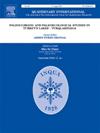古代朝鲜的桃(Prunus persica)栽培:考古植物学研究
IF 1.8
3区 地球科学
Q3 GEOGRAPHY, PHYSICAL
引用次数: 0
摘要
考古植物学研究传统上优先考虑种子繁殖的一年生作物,而对木本多年生植物的栽培给予的关注相对有限。为了解决这一空白,本研究对韩国考古遗址中发现的桃内果皮进行了研究,以探索桃种植的社会背景。虽然在史前遗址偶尔会发现桃内皮,但公元前100年以前在该地区种植桃内皮的证据仍然有限。虽然树木栽培的社会条件——长期的土地投资和领土——在许多史前遗址已经建立起来,但果树种植直到公元前100年之后才出现。新仓洞(约公元前14年-公元243年)的桃内果皮表现出不完全驯化的特征——细长和压缩,但相对较小,表明早期的栽培阶段或野生形式的收获。相比之下,后来的桃内果皮明显更大,拉长,和压缩,类似于现代品种。大约公元前100年后,桃子被作为陪葬品,凸显了它们的象征价值,这可能促进了公元第一个千年期间桃子种植在朝鲜半岛的扩张。本文章由计算机程序翻译,如有差异,请以英文原文为准。
Peach (Prunus persica) cultivation in ancient Korea: an archaeobotanical examination
Archaeobotanical research has traditionally prioritized seed-propagated annual crops, with comparatively limited attention given to the cultivation of woody perennial plants. To address this gap, this study examines peach endocarps recovered from Korean archaeological sites to explore the social context of peach cultivation. While peach endocarps are occasionally found at prehistoric sites, evidence for their cultivation in the region before 100 BC remains limited. Although the social conditions necessary for arboriculture—long-term land investment and territoriality—were established at many prehistoric sites, fruit tree cultivation did not emerge until after 100 BC. Peach endocarps from Sinchang-dong (ca. 14 BC–AD 243) exhibit traits indicative of incomplete domestication—elongated and compressed, yet relatively small—suggesting an early cultivation stage or the harvesting of feral forms. In contrast, later peach endocarps are significantly larger, elongated, and compressed, resembling modern cultivars. The inclusion of peaches as burial goods after approximately 100 BC highlights their symbolic values, which potentially facilitated the expansion of peach cultivation across the Korean Peninsula during the first millennium AD.
求助全文
通过发布文献求助,成功后即可免费获取论文全文。
去求助
来源期刊

Quaternary International
地学-地球科学综合
CiteScore
5.60
自引率
4.50%
发文量
336
审稿时长
3 months
期刊介绍:
Quaternary International is the official journal of the International Union for Quaternary Research. The objectives are to publish a high quality scientific journal under the auspices of the premier Quaternary association that reflects the interdisciplinary nature of INQUA and records recent advances in Quaternary science that appeal to a wide audience.
This series will encompass all the full spectrum of the physical and natural sciences that are commonly employed in solving Quaternary problems. The policy is to publish peer refereed collected research papers from symposia, workshops and meetings sponsored by INQUA. In addition, other organizations may request publication of their collected works pertaining to the Quaternary.
 求助内容:
求助内容: 应助结果提醒方式:
应助结果提醒方式:


